Pimples, which are more delicately called acne, can cause hysterics in any girl, because when you look at all this inflamed darkness, your mood immediately drops below the baseboard. While this is easier for guys, for girls acne is a real mark of the devil, which is very difficult to get rid of. Without noticing it, we can provoke the appearance of acne on our face and in an attempt to get rid of it we only make it worse. Next you will find 5 real stories of girls who were able to get rid of acne, and this is how they did it.
Kali Kushner @myfacestory
Kali Kushner is a 22-year-old student from America who, when looking at her “before” and “after” photos, cannot help but exclaim: “This is amazing!” On her Instagram page, the girl blogs about her skin life, where she tells followers about her journey and struggle with acne.
Since she was a teenager, Kali has been searching for a way to help her achieve clear, healthy skin. But neither pharmacy ointments nor care creams helped her, and sometimes even worsened the situation. After trying many remedies, Kali turned to an isotretinoin-based drug known as Accutane. This is a structural analogue of vitamin A - it helps dissolve fatty plugs that clog pores. In addition, the girl took vitamin C and used a dermaroller. It only took a couple of months, and Kali finally saw improvements in her skin: fewer breakouts, fewer scars, and no more redness.
Currently, Kali has stopped taking Accutane due to side effects: back pain, dryness and dehydration. Now Accutane is no longer available in America, since all the pros and cons of this drug have not been studied.
Molly Greenblatt
Molly suffered from acne for 5 years. Cleansing foams, oils, tonics - nothing helped against the hated acne. The girl even resorted to a remedy similar in properties to the drug that Kali Kushner took, but it did not bring her long-term results. Then Molly decided to take a more radical step - stop washing her face.
Of course, Molly did not avoid getting water on her face: she calmly took a shower or bath, but did not use any special cleansers. Sticking to the plan, a year later the girl saw cleaner and smoother skin in the mirror: the rashes had almost disappeared, and her complexion had improved.
Rachel Crowley @asprinkleofhealthandbeauty
Since childhood, Rachel suffered from ridicule from peers who mocked her because of her acne. She grew up as an insecure girl, embarrassed by her skin and did her best to hide the rashes on her face under a ton of makeup. At the age of 18, Rachel had the opportunity to participate in a local beauty pageant, but she refused to participate, being too insecure due to her acne. This moment became a turning point in Rachel’s fate - she decided that it was time to get rid of acne once and for all and show everyone what she was capable of.
The girl decided to conduct an experiment with her diet, gradually eliminating one product at a time from her usual menu. Imagine her surprise when it turned out that the main enemy for her skin was sugar and fast carbohydrates: “I didn’t eat these foods for just three days and increased my consumption of saturated fats. And guess what? No new breakouts!”
Now the girl adheres to a vegan diet, which involves the consumption of thermally unprocessed foods. Rachel says don't be afraid to cut sugar out of your diet for a while. In her opinion, it is the excessive consumption of sweets that can negatively affect the skin.
Anna Zelentsova @zelencanna
This girl's story is somewhat different from others. Anna was never genetically predisposed to acne - even as a teenager, her skin remained clear and well-groomed. However, over time, skin rashes overtook her too. The girl turned to dermatologists and looked for information on forums on the Internet. But the treatment prescribed by the doctor only made the problem worse. However, Anna did not despair and did not take her situation for granted, but continued to fight the hated acne, but in other ways.
Anna reviewed her diet, eliminating milk, pure sugar and sweets with a chemical composition, such as store-bought marmalade and chewing candies. In addition, the girl took a course of antibiotics, which are prescribed to people with a certain degree of acne. Anna also started taking vitamins and healthy fats Omega-3 and Omega-6 in capsules. Thanks to an integrated approach to the problem, the girl was able to overcome acne in just a few months! And although Anna herself followed somewhat alternative methods of dealing with acne, she advises her subscribers to first of all contact competent doctors.
Miroslava Zhemchugova mira_slava91
In the fight against acne, blogger Miroslava Zhemchugova resorted to gentle peelings, deep cleansing, and laser treatments, but in the end nothing saved her from rashes on her face, back and shoulders. The more the girl tried, the more her skin condition worsened. Even doctors and dermatologists seemed unable to help. But Miroslava did not despair and decided to cure her skin on her own. The result is obvious!
Miroslava believes that the scientific approach has not been canceled: having studied a sufficient amount of research and work on the topic of skin diseases, it is quite easy to defeat acne. Miroslava recommends visiting the online platform International Alliance of Dermatologists, where you can find all the necessary information. For prevention, the girl advises taking a complex of vitamins A, E, C and zinc capsules - a building material for our skin and the body as a whole. She is convinced that everyone should be able to understand the problem on their own, but notes that it is very important to find a good specialist.
Why do they say about pimples that they pop up? Because these untidy bumps always appear suddenly, singly or in entire colonies. No one is immune from such a surprise. A particularly favorite place for rashes is the face. Let's look at what types of acne there are on this part of the body and what they look like.
How do acne appear?
The elements of the rash localized on the skin of the face are varied. They arise as a result of inflammation in the sebaceous glands. The development of acne occurs in stages: the glands secrete an oily substance - sebum. It, along with dead cells, is removed from the ducts to the surface of the skin through the pores.
Sebaceous glands are associated with hair follicles. Due to the increased production of sebum, the excretory ducts cannot cope with cleansing, which leads to their clogging. In clogged canals, cysts - comedones - are formed, and a nutrient medium is created for the proliferation of microorganisms. Bacteria break down fat and its derivatives - fatty acids, damaging the skin and triggering the inflammatory process. This leads to the appearance of rashes on the face. The mechanism of development and structure of a pimple in cross-section can be seen in the figure.
There are two types of comedones - closed and open. When completely blocked, comedones do not come to the surface, forming whiteheads.
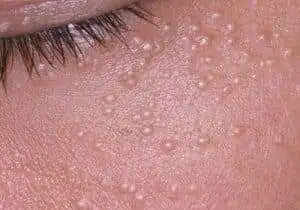
Closed comedones (whiteheads)
With partial blockage, open comedones appear - blackheads. This happens because sebum is partially oxidized under the influence of oxygen, reacts with melanin, and the head of the comedone turns black (see photo below).
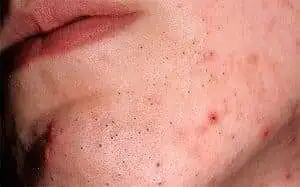
Open comedones (blackheads)
The collective name for inflammatory diseases of the sebaceous glands is acne. This term is often applied to acne and pimples.
Classification of acne according to inflammatory characteristics
The process of suppuration continues. Inflamed comedones form the following types of acne:
- Papules (nodules) - dense flat or cone-shaped formations with a diameter of 1-3 mm, slightly rising above the skin level. The color of acne varies from pale pink to red and bluish-purple. Swelling can be observed around the papule. The pus is located deep in the layers of the epidermis, so there is no inflamed white head on the surface. Papules are usually formed from closed comedones.
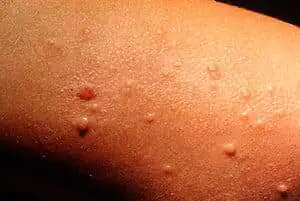
Papules
- Pustules - elements with purulent contents of a spherical, cone-shaped or flat shape. They are formed primarily (independently) or secondary - from papules. The diameter of pustules can range from 1 to 10 mm. On the surface of the formation, surrounded by a red rim, there is a white purulent head. The presence of yellowish or greenish tints indicates the addition of a secondary infection. When a pustule is injured, the walls of the blood vessels are destroyed and the pus mixes with the blood. It is not recommended to squeeze out the white head at home: there is a risk of infection of the open wound. Pustules can be dried with alcohol-containing and anti-inflammatory drugs (Zinerit, tea tree oil, boric alcohol).
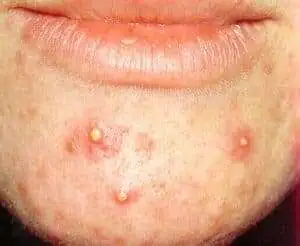
Pustules
The outcome of the rash depends on the depth of damage to the layers of the dermis. In mild form, papulopustular elements heal without leaving marks. If the inflammation penetrates deeply and damages the skin structure, healing can occur with the formation of scars. You shouldn’t let the situation get worse, especially if the rashes multiply. In the absence of timely treatment, the clinical picture may change for the worse and lead to serious complications.
Severe forms of acne
In clinical practice, there are types of acne on the face with a severe inflammatory process. These include elements of the following types:
- nodular cystic;
- inductive;
- conglobate;
- fulminant;
- phlegmonous;
- necrotic.
Nodular-cystic acne is manifested by the formation of deeply recessed infiltrative elements and cavities filled with pus on the body and face. Large sebaceous plugs first transform into large (more than 1 cm) pimples, then they can grow into cysts, creating sebaceous passages under the skin. Healing is accompanied by a scarring process. Nodular cystic acne is painful and requires treatment under medical supervision, including surgery.
Inductive Pimples are the most common severe form of acne. They are compacted papular or papulopustular nodes with severe inflammation. Rashes occur in adolescence and occur against the background of increased sebum secretion. Deep nodes can unite into extensive clusters. Induration acne always leaves scars.
Conglobate (multiple, piled up) Acne most often bothers teenagers during puberty. This is a recurrent form of acne with a long course - up to several years. It is characterized by the fusion of comedones, as a result of which large spherical elements are formed deep in the dermis. The nodes are painful to the touch. At first they are dense, then soften and fill with purulent exudate. When conglobate acne heals, ulcers, fistulas, and rough hypertrophic scars can form.
Fulminant (fulminant) pimples are a type of cystic acne with nodular purulent elements. It is more common in boys aged 13-16 years. Fulminant acne rashes occur suddenly, against the background of mild to moderate acne. Then they merge with each other, forming painful plaques covered with dirty, loose crusts. The ulceration in many cases ends with scarring.
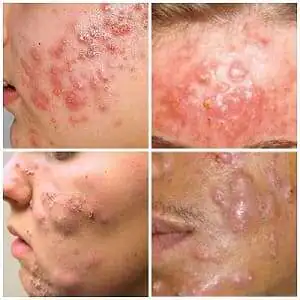
Severe forms of acne on the face
Phlegmonous elements arise when inflammation develops in the deep layers of the epidermis, and small cavities containing pus are formed there. The surface of the skin is covered with small tubercles. Gradually they merge with each other, forming large crimson-red nodes. Subsequently, the mounds open in several places, and the purulent contents come out through the holes. Exudate is released in large quantities and contains blood.
Necrotic acne is characterized by rashes of pink or purplish-red nodules about the size of a pinhead. In the center of the acne, a pustular lesion forms, which, when dried, becomes covered with a bloody black crust. After the crust comes off, a depressed scar remains in place of the acne.
Severe forms of acne often last for years and are difficult to treat. Consultation with a dermatologist is required! The choice of drugs for treatment is determined by age, gender, advanced stage of the process, skin condition, test results, and the presence of concomitant diseases.
Rashes other than acne
There are diseases accompanied by a rash that looks like acne. However, when acne forms, there are no comedones, and the appearance of rashes is due to other mechanisms. Such diseases are included in the group acneiform dermatoses. These include perioral dermatitis, rosacea, rosacea, drug rash, skin tuberculosis, small nodular sarcoidosis and other ailments.
Acne-like rashes occur in some people after prolonged exposure to UV rays. This phenomenon is called “sun acne.” The disease becomes more active in the spring and summer. The appearance of sun rashes is completely identical to ordinary acne - these are small, dense papules of a reddish color. Pimples are predominantly located on the forehead, cheeks and chin, as well as exposed parts of the body.
Doctors also classify bodybuilding acne. The appearance of a rash is directly related to the use of steroid hormonal drugs. Their intake increases the secretion of sebum, as a result of which the skin becomes covered with nodular-cystic elements. Characteristic features of the rash: absence of comedones, monomorphism of the rashes and their rapid regression after discontinuation of steroids.
Age-related types of acne
A single generally accepted classification of acne has not yet been created, but there are developments that modern medicine is guided by. The most complete classification is that proposed by Plewig and Kligman. Types of acne are grouped by age.
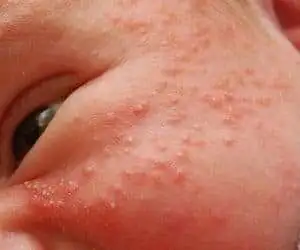
Acne in newborns
Newborn acne. It appears under the influence of maternal hormones in the prenatal period, due to excessive secretion of sebum. The rash is localized in the forehead, cheeks, nasolabial folds, tip and wings of the nose. Pimples have the appearance of small pinpoint papules of white color, sometimes with a yellowish tint. Neonatal acne resolves within 2 weeks after birth.
Acne babies can develop in children 3-6 months old, more often in boys, and persist up to 4 years. The cause of the rash is often attributed to increased testosterone levels caused by adrenal hyperplasia. Acne can become severe and result in skin scarring.
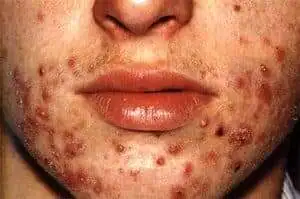
Acne vulgaris in adolescents
Youthful (vulgar) acne most often occur between 12 and 16 years of age. According to statistics, 90% of teenagers experience acne in one form or another. Basically, this is a papulopustular rash, which is localized only on the face or on the face and back. For most teenagers, their skin clears up by the age of 18-20.
Late acne - rashes that persist after puberty or first develop in adults. They can be a manifestation of serious diseases accompanied by an increase in plasma androgen levels. Also, late types of acne include premenstrual and postmenopausal pimples in women. They are usually localized on the chin. The cause of late acne in girls and women can be polycystic ovary syndrome or pathology of the adrenal glands.
There are also provoked acne. This category includes mechanical rashes (caused by rubbing your face with your palms, wearing hats, headbands, etc.), oil rashes (caused by prolonged contact with oils in skincare products and oiled clothing) and cosmetic rashes (the result of overuse of cosmetics).
In general, the classification of facial rashes includes many types and subtypes of acne, as well as the causes of their appearance. Differential diagnosis should be carried out by an experienced physician. In most cases, timely treatment will help avoid complications and severe forms of acne.
From this article you will learn:
- acne on the face: causes of appearance,
- acne on the face - photo, how they differ from acne,
- acne - treatment.
Facial acne is a disease in which plugs consisting of sebum and desquamated skin cells form in the skin pores. The disease is usually called by the terms: acne or acne, and acne itself is often called acne vulgaris or comedones.
Acne is usually divided into two types –
- Closed acne (Fig. 1-3) –
they are white in color and look like white bumps on the surface of the skin. The plugs inside them are not visible.
- Open acne (Fig. 4-6) –
plugs are clearly visible inside the pores, because are black. The dark color of corks is not caused by dirt, as is commonly believed, but by the skin pigment melanin.
Acne: photo
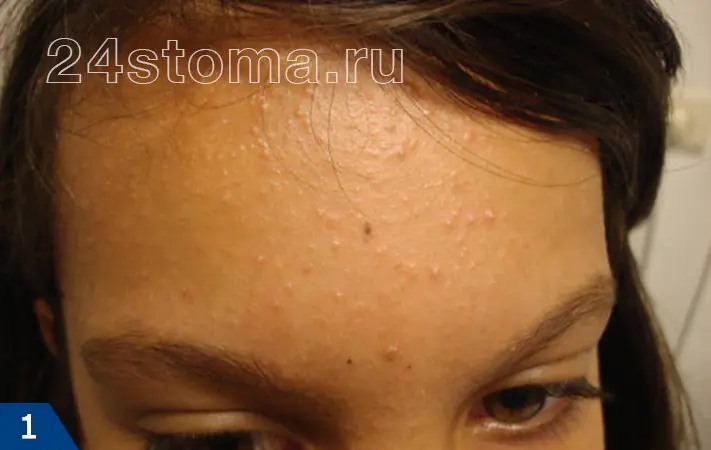
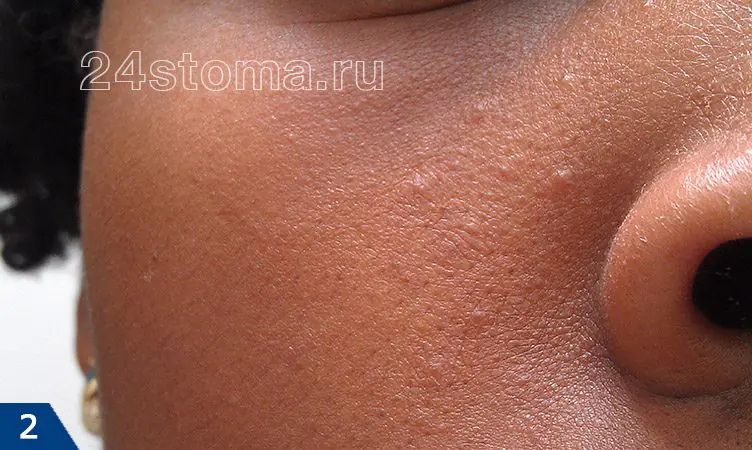
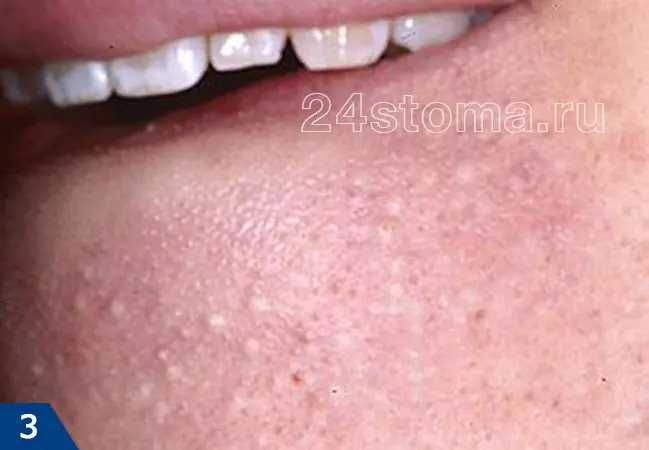


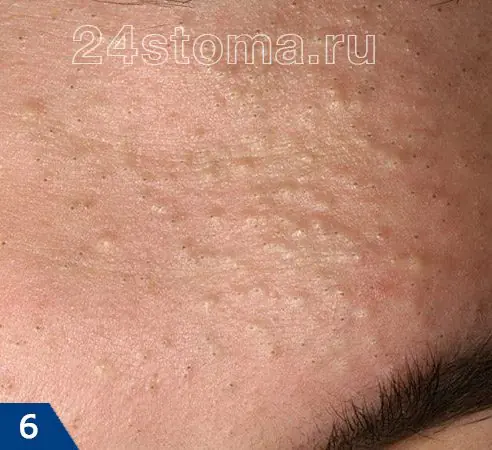
Almost all people have acne on their nose. Acne on the forehead, chin, and cheeks is quite common.
In many articles, incompetent authors often call acne vulgaris - pimples. Although acne and pimples are completely different things, which are even treated differently... With acne, there are fat plugs in the skin pores, with a complete absence of inflammation inside and around them. 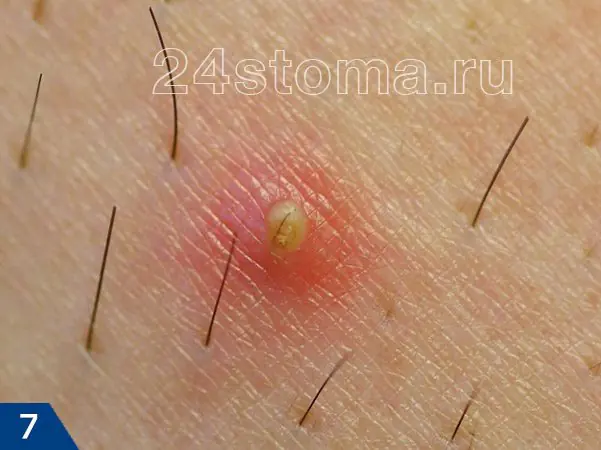
A pimple is a hair follicle that has already festered under a plug, around which inflammation develops (Fig. 7).
In dermatology there is also the term Acne. This term combines both acne and pimples, and also includes the consequences of the healing of large pimples and cysts - scars and age spots.
Acne on the face: causes of formation
Hair follicles and the sebaceous glands located around them take part in the formation of acne. From such follicles hairs grow on the face, penetrating the surface of the skin through the skin pores (Fig. 8a). The sebaceous glands, in turn, produce sebum, which penetrates through ducts first into the lumen of the hair follicle, and then through the pores onto the surface of the skin.
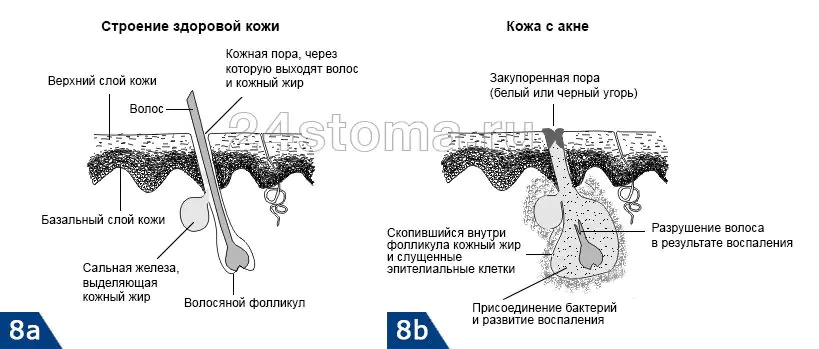
The appearance of acne is associated with 2 main factors:
- Increasing the production of sebum by the sebaceous glands -
it usually occurs in adolescents during puberty. During this period, the amount of hormones (androgens) in the blood increases, which are produced both in men and in smaller quantities in women. Androgens tend to enhance the function of the sebaceous glands.
- Keratosis of the epithelium of the hair follicle -
The inner walls of all hair follicles are covered with epithelial cells. These cells, like any other cells on the surface of the skin and mucous membranes, are gradually exfoliated, and new ones appear in their place. A disruption in the rate of keratinization of epithelial cells (called keratosis) leads to an increase in the number of exfoliated dead cells in the lumen of the follicle.
As a result of these two processes, skin pores become clogged with plugs consisting of sebum and desquamated epithelial cells. Moreover, the sebaceous glands still continue to produce sebum. But due to the plugs, it can no longer reach the surface of the skin and accumulates in the lumen of the hair follicle, stretching its walls (Fig. 8b).
If such plugs form deep in the skin pore (closer to the hair follicle), then closed whiteheads appear (Fig. 9,1,2,3). If plugs form in the upper part of the skin pores, then open blackheads with black heads are formed (Fig. 10,4,5,6).
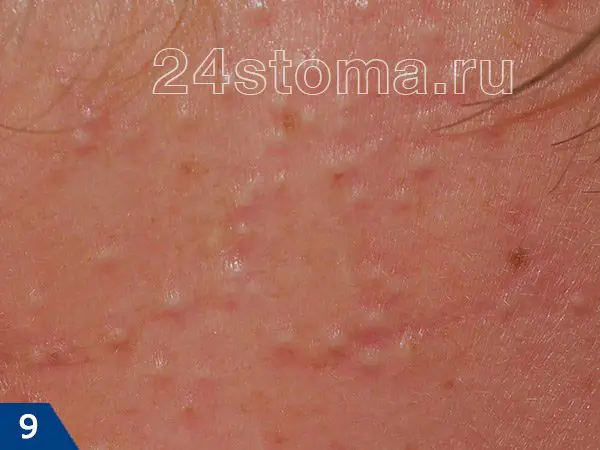
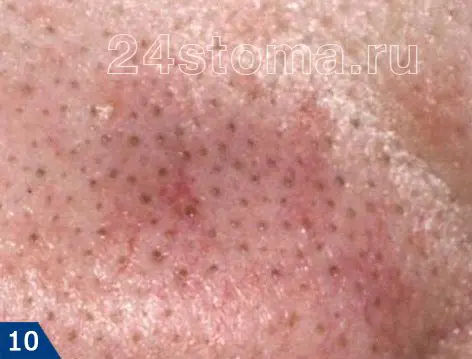
How acne forms from acne –
If bacteria brought from the surface of the skin are inside the clogged hair follicle, inflammation develops, which consists of the formation of pus inside the follicle. This is a real pimple (Fig. 7), and not an acne.
You will find more information on the treatment of acne in our article:
→ “All about acne treatment”
The main reason for acne is the increased production of androgens during puberty. However, this is not the only factor that contributes to the appearance of acne. Predisposing factors are also:
- Fat-based cosmetics –
Skin care products and cosmetics can cause acne if they are oil-based. For the face, it is advisable to use products that are water-based (such products do not clog skin pores).
- Birth control pills and hormonal changes –
Women may experience a regular exacerbation of acne once a month, associated with hormonal changes in the premenstrual period. Birth control pills can only stimulate acne if the pill contains only pure progesterone.
- Medications -
If you are taking anticonvulsants, bromides, lithium, iodides, prednisolone or its analogues, as well as steroid hormones (usually taken by athletes), keep in mind that they can stimulate the appearance of acne. - Increased sweating -
If, due to physiology or due to increased physical activity or work conditions, you often sweat, this can aggravate your acne.
Acne: treatment at home
How to get rid of acne?... The most difficult thing in treating acne is making the right choice of preparations for treating facial skin. Anti-acne products are sold in pharmacies and on the Internet in huge quantities. Moreover, many of them are practically ineffective, and only a dermatologist or cosmetologist can correctly evaluate and select drugs for treatment.
- It is better to start treatment of acne in adolescents as early as possible, because... in this case, it is possible to prevent the transformation of acne into pimples, after which scars and age spots remain on the skin.
- Treatment of acne in women is carried out in the same way as for other groups of patients (you will see basic therapy below). If the effect of basic therapy is insufficient, birth control pills or spironolactone may be prescribed.
Acne treatment regimen –
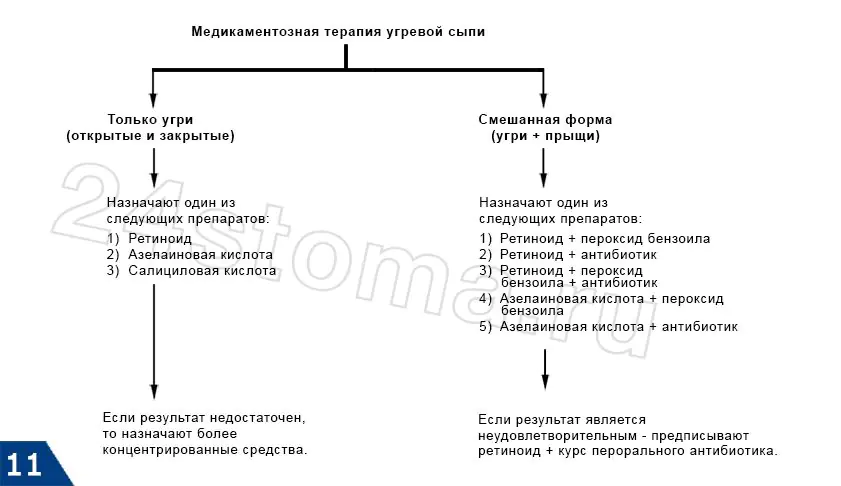
Below you can familiarize yourself in detail with the groups of drugs outlined in the scheme.
Preparations of the Retinoid group belong to vitamin A derivatives. And this is probably the best remedy for acne. The use of retinoids helps remove existing plugs (blackheads) from the skin pores, and also helps prevent the appearance of new acne. The highest effectiveness is with retinoids in the form of lotions; Gels are slightly inferior to them, and creams are the least effective.
Modern retinoid drugs are made on the basis of Tretinoin, Adapalene or Tazarotene. Keep in mind that preparations with retinoids can be either single-component or combined. Monocomponent retinoids are used when there is acne on the skin (without acne), and combined retinoids are used when there is a mixed form, i.e. when the skin has both blackheads and pimples.
Monocomponent retinoids -
1) with tretinoin: Retin-A (USA), Lokacid (France) and Airol (Switzerland)
2) with adapalene: Differin (France), Clenzit (India), Deriva (India)
3) based on tazarotene: Zorak (Germany), Tazret-gel (India).
Combined drugs -
Retinoids are usually combined with either an antibiotic or benzoyl peroxide. These components are very effective when, in addition to acne, there are inflamed pimples on the skin.
1) “Epiduo” (France), “Effezel” (France) – retinoid Adapalene + benzoyl peroxide,
2) “Deriva-S”, “Klenzit-S” - contain Adapalene + the antibiotic clindamycin.
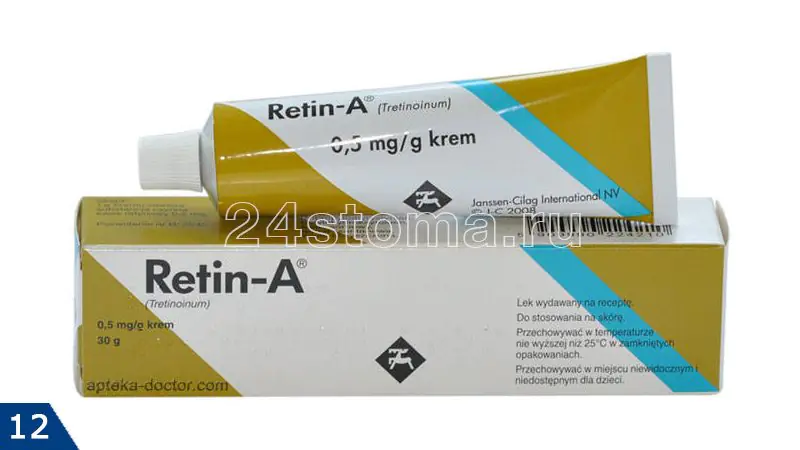
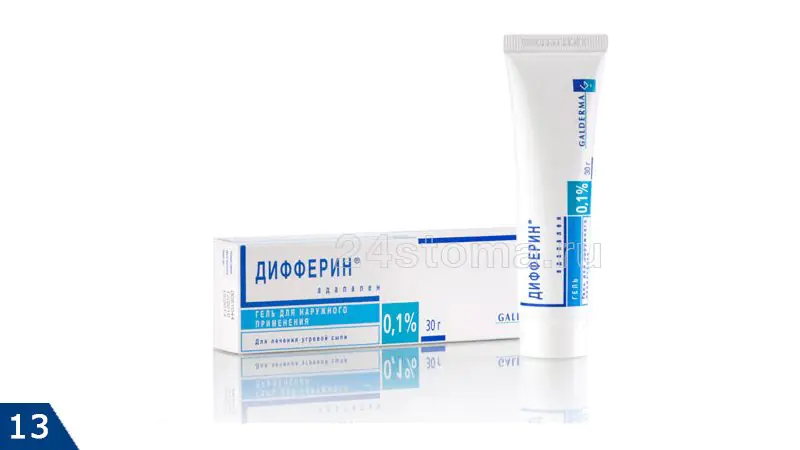
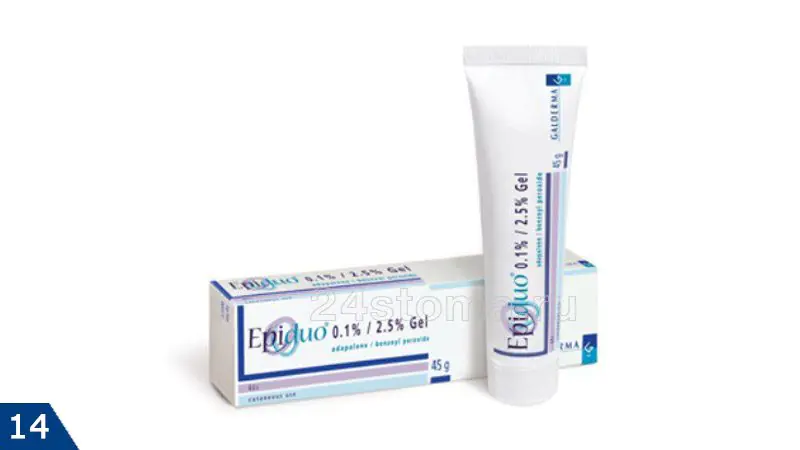
Application scheme –
Retinoids are used only once a day (at night) - 20 minutes after washing your face with a mild cleanser. The course of treatment is at least 3 months, but you will see a good result within 5-6 weeks. You need to start using the drug 3 times a week, gradually moving to daily use. In this case, the skin will not be very irritated and will quickly get used to it.
- slight burning or skin irritation may occur,
- retinoids should not be used together with peeling products (significant skin irritation is possible),
- increased skin sensitivity to the sun (be sure to use sun protection on sunny days).
Preparations based on azelaic acid exfoliate dead layers of skin, helping to remove traffic jams, and also have an antibacterial effect. For acne, azelaic acid is prescribed as an independent treatment, and for acne with pimples - as an addition to benzoyl peroxide or antibiotic gel.
For oily skin it is better to use gels, and for dry skin - creams with azelaic acid. Examples of drugs: Skinoren (Germany), Azix-derm (India), Azogel (Russia), Acne-derma (Poland).
Features of application –
The drug is applied 2 times a day to areas of the skin that have acne. The effect will be noticeable within 1 month from the start of treatment. The course of treatment is at least 3 months. The positive features of azelaic acid are that it does not increase skin sensitivity to the sun, prevents the appearance of age spots, and also causes less skin irritation.
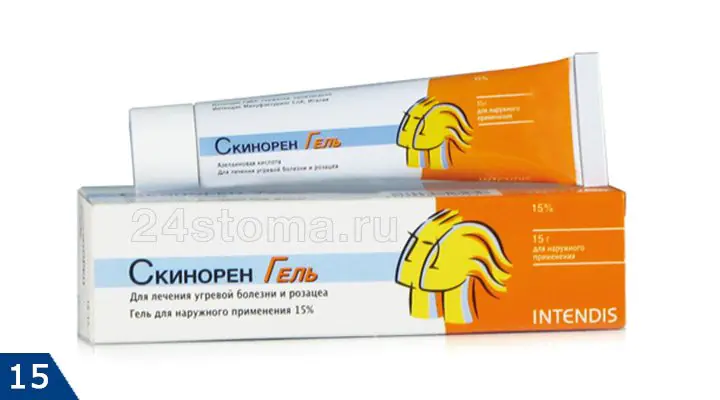
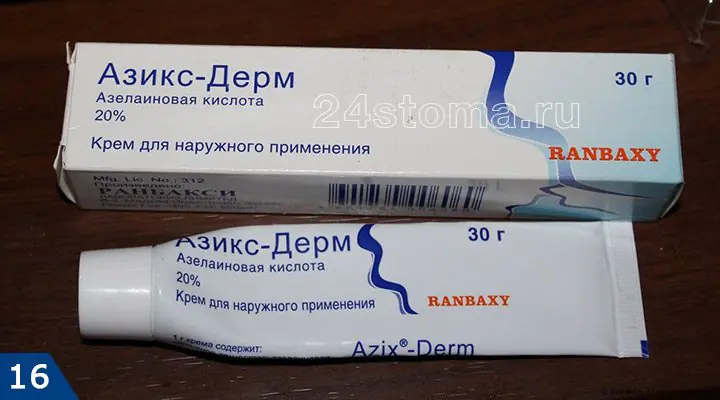
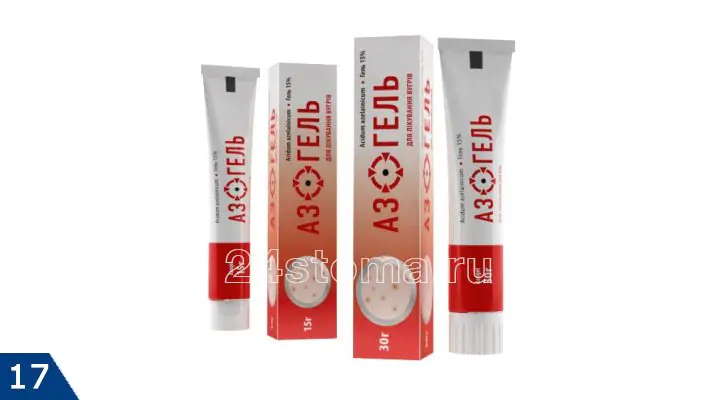
Acetylsalicylic acid has the property of dissolving the fatty substrate that makes up acne, as well as exfoliating dead skin cells. Acne preparations based on salicylic acid come in 0.5% or 2% concentrations, both in the form of lotions and gels. An example is the “Clearasil” line of products in the form of lotion, cream and gel.
For acne, salicylic acid has a good effect, but it is still at least 2 times lower than from the use of retinoids. But the use of salicylic acid not for acne, but for pimples, is generally ineffective and simply makes no sense.
Features of application –
Be prepared for the fact that if you regularly use products with salicylic acid, your skin will become red and flaky. If you have dark skin, keep in mind that salicylic acid, when used regularly, will cause pigment spots to appear on the skin.
Treatment of acne with antibiotics cannot be effective because acne is not an inflammatory or infected formation. An acne is a pore clogged with sebum, in the depths of which sebum secreted by the sebaceous glands accumulates. Therefore, antibiotics are not used for acne, but for acne, on the contrary, this is one of the main types of treatment.
Summary -
Above we have listed an exhaustive list of drugs that are used specifically for acne. If the result of treatment with these drugs was insufficient, then similar drugs with higher concentrations of active elements are selected.
Important: if you have not only acne, but also pimples at the same time -
in this case, in addition to retinoids and azelaic acid, the following groups of drugs are used:
- gels, lotions and creams with benzoyl peroxide (very effective!),
- or antibiotics in the form of gels for topical use.
You can find out about the properties and brands of these drugs in the article: “Drugs for the treatment of acne”
In addition to the basic treatment with retinoids, azelaic or salicylic acids, you must always follow three important rules...
Regular cleansing and skin care –Wash your face twice a day only with mild cleansers (such as Neutrogena). This will keep your skin clean and minimize irritation. You also need to avoid using oil-based cosmetics and skin care products (they clog pores). Use water-based products only!
Mild peeling preparations can be used periodically. You can do this peeling even at home, but you just need to use professional products for home use, but not soda, aspirin or lemon. Such products most often contain glycolic acid, which exfoliates dead surface skin cells, which also helps open pores.
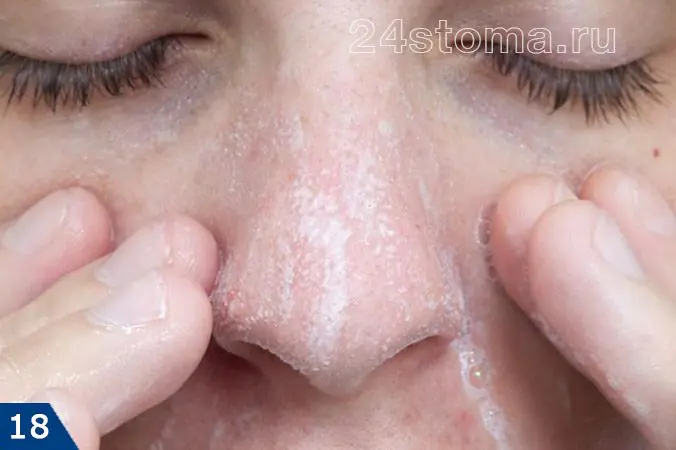
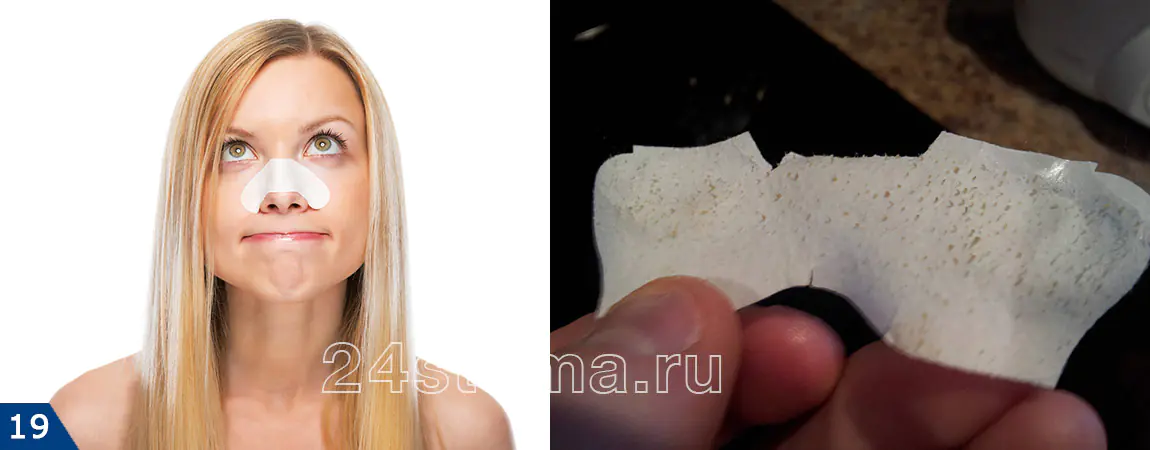
To reduce the amount of sebum inside and on the surface of the skin, as well as oily skin, use the following products:
→ special toners for cleansing oily skin,
→ special cosmetic strips (Fig. 19), which are attached to the surface of the skin on the nose, forehead, cheeks or chin to remove sebum from the pores (Nivea, “Propeller”, etc.).
→ special cosmetic masks will help draw out sebum from the skin.
If you only have acne, then you do not need to use these products. However, if acne periodically turns into pimples, then you can use benzoyl peroxide-based bactericides (once every 2 days) to prevent the appearance of pimples.
Is it possible to squeeze out blackheads?
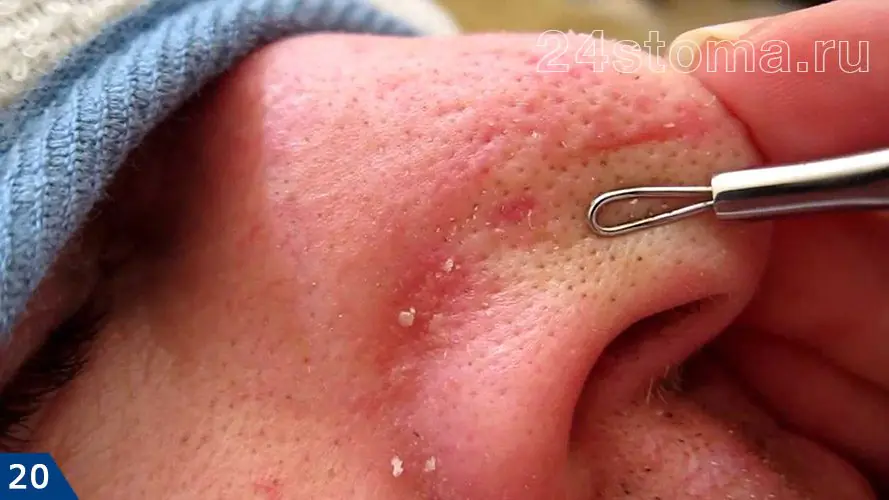
You need to make sure to keep your hands away from blackheads. This is due to the fact that squeezing out acne can: firstly, lead to deep infection and the development of purulent pimples, and secondly, in some cases, when compressed (especially closed acne), the membrane in which the sebaceous gland fat is located ruptures.
This leads to sebaceous gland fat not reaching the surface of the skin, but deep into the soft tissues, which will cause inflammation in the deep layers of the skin and suppuration. It is best to use special strips and treatment masks designed to extract sebum from the pores.
But in some cases, dermatologists and cosmetologists still recommend acne removal. This is done using special tools “comedone extractors” (Fig. 20 and video).
Squeezing out blackheads: video
We hope that our article on the topic: How to remove acne from your face was useful to you!



